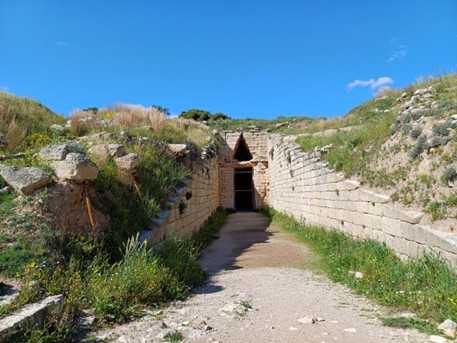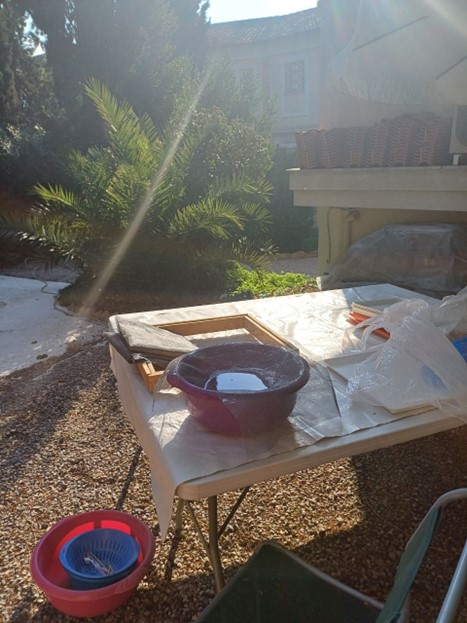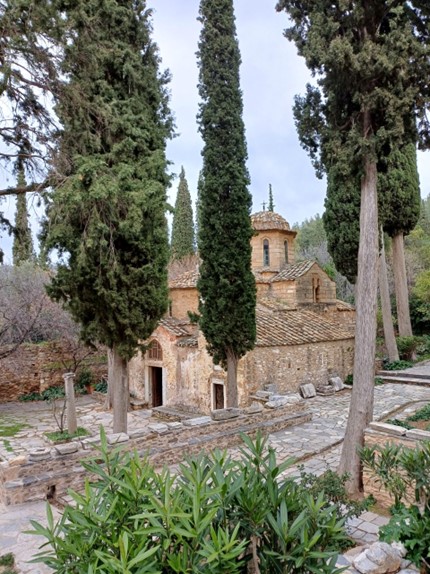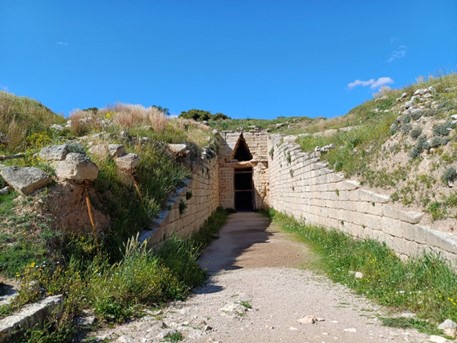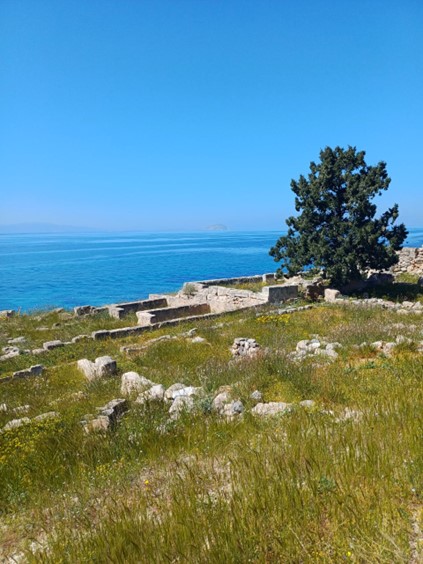By Sofia Mathioudaki, MA Museum Studies (Heritage Studies), University of Amsterdam (Holder of a NIA-study grant for MA students or recently graduated)
I first became acquainted with the Amst. I.D. 75 manuscript through an internship at the Allard Pierson around mid-March 2023, as part of the study programme of the MA Museum Studies of the University of Amsterdam. Little did I know that this object would end up becoming the case study of my thesis and by extension the reason I would be granted a scholarship at the Netherlands Institute at Athens (NIA), which would allow me to conduct additional research on the manuscript’s provenance and work on my thesis subject.
Around the same period, thanks to Dr. Astrid Balsem and Professor Emeritus Arnold van Gemert, information on the provenance of this 11th-century manuscript was already starting to resurface indicating an increasingly clear connection to Northern Greece. It didn’t take long for me to understand that the information around it was denser than I initially thought, spanning from 1886 to the present day. However, the research that had been previously conducted was either outdated or not particularly focused on the Amst. I.D. 75, rather emphasizing the wider collection that was looted from the monastery of Eikosifoinissa, between the cities of Drama and Serres. As a result, drawing on the new research findings that both A. Balsem and A. van Gemert were kind enough to share with me, I decided to incorporate the story of this manuscript in a wider context, that of looted heritage in the Balkans and, secondarily, in the Netherlands. This, eventually, became the subject of not only my internship from April 2023 and on but also the subject of my master’s thesis, trying to investigate the historical-cultural factors that drove this object’s original displacement and later illicit transfer to the West.

Many months later, in February 2024, and after receiving a positive evaluation of my application to NIA, I ended up returning to Athens, where I had originally acquired my BA diploma in Archaeology and History of Art from the NKUA (National and Kapodistrian University of Athens). This has allowed me to benefit from the proximity to many libraries, accessing several bibliographical sources that would otherwise be difficult to study, while, also, focusing on the material that I had already collected both in Amsterdam and in Sofia, Bulgaria, during November and December 2023 while visiting the “Prof. Ivan Dujčev” Centre for Slavo-Byzantine Studies.
Most importantly, though, it gave me the opportunity to travel to Thessaloniki, where the majority of relevant researchers reside and several significant research centres are located. There, I visited the Centre for Byzantine Research and benefited from their rich collection of books, publications and others. From there, I continued my research at the Library of the Aristotle University of Thessaloniki, which complemented the material that I had already examined. For instance, during that visit of mine, I was able to study the first recorded mention of the manuscripts collection of the monastery of Eikosiphoinissa in an 1886 catalogue by A. Papadopoulos-Kerameus.
Moreover, I had the chance to further expand my knowledge on the 2nd Bulgarian Occupation period (1916-1918), during which the looting incident took place, at the Institute for Balkan Studies, which truly preserves a bibliographical and archival treasure for anyone interested in this field, or, more specifically, in my case the Greek-Bulgarian relations preceding and following the looting of 1917. I, also, had the chance to meet and discuss with Mr. Efthimis Litsas, director of the Greek Palaeographic Society, who was also kind enough to forward some complementary material to me after our meeting.
Additionally, I visited the monastery of Panagia Eikosifoinissa, located on the outskirts of Drama and Serres. The journey was an adventure by itself, including 2 different bus routes and a 15-minute taxi drive through the Paggaio Mountain. My initial goal was to visit the monastery in order to have a first-hand inspection of the space and understand how the looting operation was implemented. My visit exceeded my expectations, and thanks to the generous assistance of the residing nuns, I was also able to study an up-to-date (and surprisingly unavailable in all previous libraries) detailed work by G.K. Papazoglou, published in 2017, marking the 100th anniversary of events of 1917. At the same time, the value of this visit extends to exploring the monastery’s current stance and activity regarding the looted manuscripts, taking into consideration both international affairs and other factors.

Last but not least, my 3-month stay at NIA provided me with an excellent opportunity to become re-acquainted with the Athenian entourage in the centre of the city, allowing me to get to know Athens in a more profound way, while also reflecting on the city’s rapidly-shifting urban identity. The ever-increasing gentrification of the surrounding neighbourhoods, the commodification of the historic centre as well as the way tourists tend to interact with the city’s archaeological sites have problematized me, while also providing valuable stimuli that have enhanced my understanding of the wider socio-cultural context and have inspired me to perhaps further explore this research field in the future.
My stay at NIA has been a meaningful part of this final stage of my studies at the University of Amsterdam, assisting me in expanding and, furthermore, solidifying the existing knowledge of this manuscript’s provenance, contributing to the ongoing dialogue on conflicted heritage by drawing attention to the -often academically neglected- Balkan region. Beginning this process found me overwhelmed with a plethora of information that was hard to put in order and connect with one another, but by the end of my stay at NIA, I am confident about the accuracy of the sources that I have incorporated in my study and the conclusions that I have drawn. Finally, the material that has been gathered has not only been used within the context of the thesis but will also be shared with the Allard Pierson, the institution that currently has the ownership of the Amst. I.D. 75 manuscript. For these reasons, I would like to thank the NIA for providing me with this amazing opportunity and, of course, every member of staff for taking care of all different aspects of my 3-month stay in Athens on an everyday basis.

